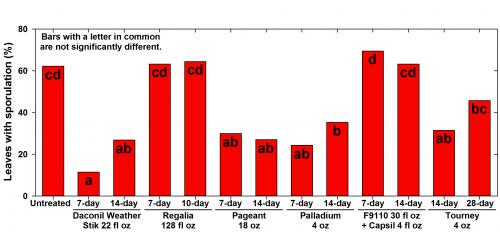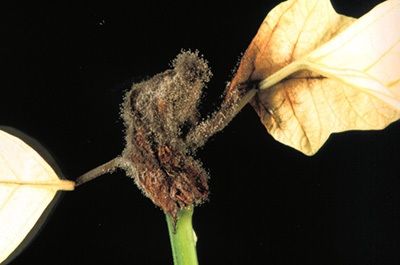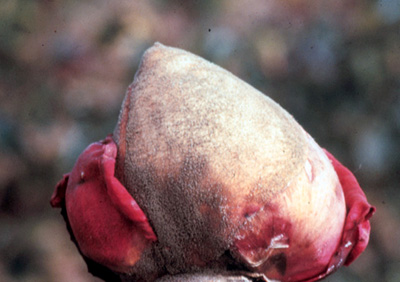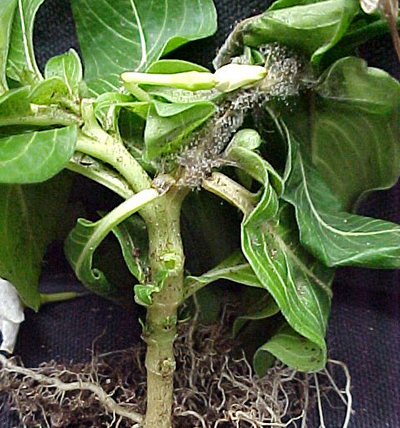B is for Botrytis blight on ornamentals
Know the ABCs of ornamental greenhouse diseases.

Botrytis cinerea is a fungus that infects many greenhouse ornamental and vegetable crops. Botrytis causes leaf spots (Photo 1), blighting (Photos 2-5), stem cankers and damping-off. Botrytis produces large masses of gray conidia or spores (hence the name “gray mold”) that can be carried on air currents to healthy plants where blight can become established. Infection that can start as a small leaf spot that can quickly coalesce into a large necrotic area or infect the cut stem surface of stock plants and progress downward, causing a dieback of the entire plant.
On bedding and stock plants, Botrytis typically becomes established and produces conidia on older lower leaves that are near the moist soil surface and under the plant canopy. Botrytis can also infect dead plant tissue in the pot or on the greenhouse bench or floor, which can be a source of future infections.
When the weather is moist and humid, susceptible plants may need to be protected from Botrytis infection. Plants may also be susceptible if they become wet from water dripping from overhead, dew or condensation. Water allows the Botrytis conidia to germinate and penetrate the plant. Watering in the morning so the foliage can dry rapidly is one way to minimize Botrytis. Reducing relative humidity by spacing plants further apart and providing good air circulation can be helpful. Reduce the relative humidity for a minimum of 24 hours immediately following the harvesting of cuttings to help “dry” the wounded stems and thereby limit stem blight.
Finding the beginnings of brown/gray fuzziness on lower leaves can signal the need for disease control measures. Sanitation is an important first step to reduce Botrytis in your greenhouse. If you have dead plant tissue on your greenhouse bench, it is likely supporting sporulating Botrytis!
Fungicides must be applied to ornamentals as a foliar spray to be effective in controlling Botrytis blight. The “A” and “B” Team tables of recommended ornamental Botrytis fungicides are the result of multiple trials conducted at Michigan State University. The FRAC code is an alphanumeric code assigned by the Fungicide Resistance Action Committee and is based on the mode of action of the active ingredient. When treating ornamentals for Botrytis blight, rotate among products with different FRAC codes to reduce the possibility of resistance developing in the Botrytis fungus.
Fungicides listed in the A Team table consistently provide effective control. The graph below shows that even the best treatments do not completely prevent infection; however, they are often necessary partners in a successful management program that includes environmental control and sanitation.
Newer ornamental products, Pageant and Palladium, make excellent rotational choices in a spray program. B Team products are a good rotational choice when disease pressure is not severe. The graph is a comparison of minimum and maximum application intervals of fungicides applied to geranium to control Botrytis. Note that although there are differences in sporulating leaves (percent) for the two intervals of each product (as shown by the bar heights), that difference is not statistically significant (as shown by letters in common on the bars).

Evaluation of minimum and maximum labeled application intervals of ornamental fungicides for control of Botrytis blight on geranium.
| Botrytis A Team (ornamental recommendations only) | ||
|---|---|---|
| Product | Active ingredient | FRAC code |
| Affirm WDG | polyoxin D zinc salt | 19 |
| Chipco 26019 | iprodione | 2 |
| Daconil | chlorothalonil | M05 |
| Decree | fenhexamid | 17 |
| Pageant Intrinsic | pyraclostrobin/boscalid | 11/7 |
| Botrytis B Team* (ornamental recommendations only) | ||
|---|---|---|
| Product | Active ingredient | FRAC code |
| Compass O | trifloxystrobin | 11 |
| Heritage | azoxystrobin | 11 |
| Insignia | pyraclostrobin | 11 |
| Orkestra | fluxapyroxad/pyraclostrobin | 7/11 |
| Palladium | cyprodinil/fludioxonil | 9/12 |
*Not recommended when disease pressure is high.
Photo 2. Botrytis sporulation on a blighted geranium leaf.

Photo 3. Blight and sporulation on poinsettia.

Photo 4. Flower blight of rose.

Photo 5. Aerial stem blight and sporulation on vinca.
Learn more about the ABCs of ornamental greenhouse diseases
- P is for Phytophthora rot on ornamentals
- P is for powdery mildew on ornamentals
- P is for Pythium root rot on ornamentals
- R is for Rhizoctonia rot on ornamentals
- T is for Thielaviopsis root rot on ornamentals
Acknowledgments. This material is based upon work supported by Cooperative Agreement 58-8062-5-036 with USDA ARS under the Floriculture and Nursery Research Initiative, and the IR-4 Project.


Dr. Hausbeck's work is funded in part by MSU's AgBioResearch.



 Print
Print Email
Email




